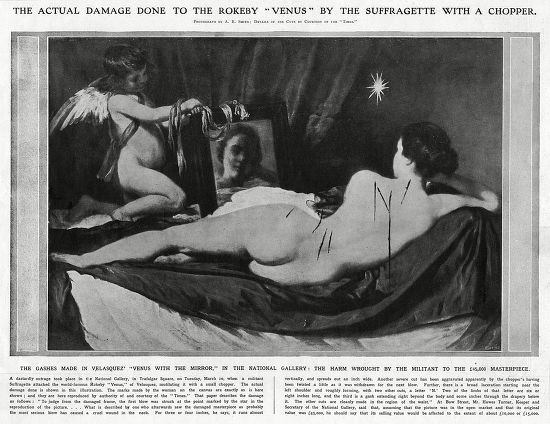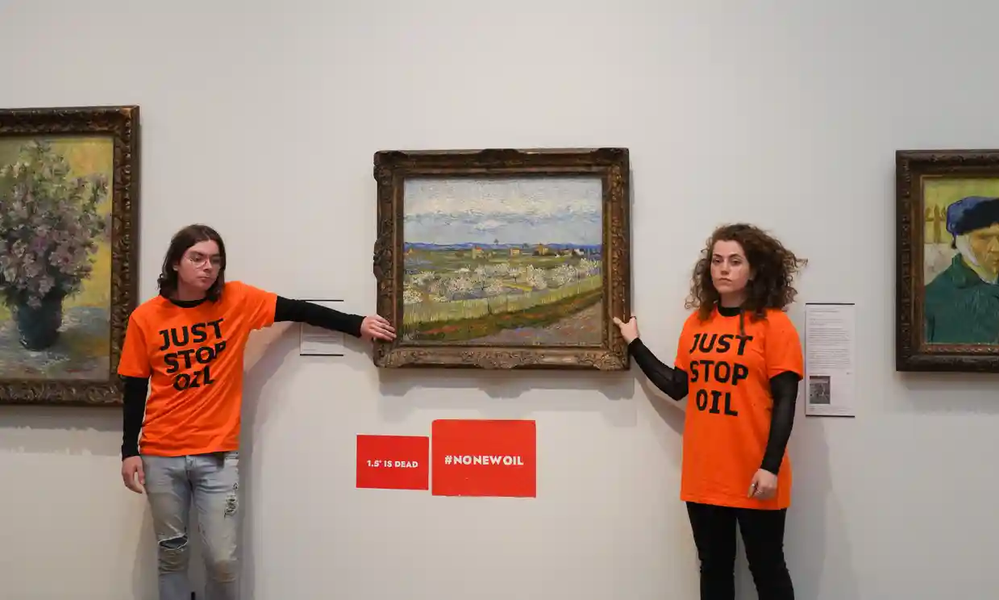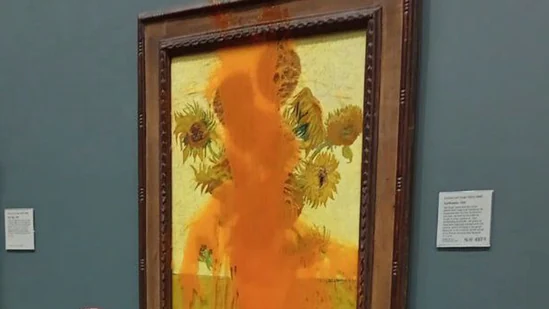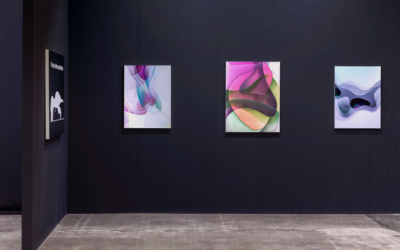Written by Harriet Maher
November 29, 2022
Why using art as a vehicle for protest isn’t the solution
There’s been a lot of art in the news lately, but not necessarily for the right reasons. We’re used to seeing Picasso, Van Gogh and Munch’s names splashed across the pages of newspapers and the internet, but typically not because they’ve been splattered with a can of tomato soup, or a handful of mashed potato. This uptick in bizarre, art-adjacent news is thanks to the climate action group Just Stop Oil who, like Extinction Rebellion, have gained a name for themselves for being on the more controversial and at times incomprehensible side of protest. Their aim is to raise awareness about the need for immediate divestment from fossil fuels (as the group’s name suggests), and to call on the British government to commit to halt all new oil and gas projects.

News story of the attack on Diego Velasquez’s The Toilet of Venus (Rokeby Venus) by a suffragette in 1914. Image source: Mary Evans Prints Online
Art as a form of protest is, of course, nothing new. And using art museums as a site for protest also dates back to at least the early twentieth century, when the suffragette figurehead Mary Richardson slashed the canvas of Velazquez’s Rokeby Venus (1647) in London’s National Gallery in 1914. But, we might ask ourselves, why? There doesn’t seem to be an obvious connection between the works of art targeted by Just Stop Oil, or even the strategy of targeting art museums in the first place. The tenuous link made by the group themselves to John Constable’s The Hay Wain, which protesters glued their hands to at London’s National Gallery in July 2022, is questionable at best. The group claimed that the idyllic scene portrayed in Constable’s iconic work would cease to exist and become a hellscape of apocalyptic proportions, if the government does not take steps to divest from fossil fuels. But even this argument seems circuitous and over-wrought, all things considered.
It should be said here, very firmly and clearly, that I am of course a firm supporter of renewable energy and an avid believer in the need to divest from fossil fuels in favour of solar, nuclear, wind, and hydro energy. I am under no illusions about the urgency and immediacy of this issue; what I want to explore here is the efficacy of intervening in and, in some cases, permanently damaging historic and valuable works of art in the name of protest.
Of course, one of the reasons Just Stop Oil presumably targets high-profile works by the likes of Van Gogh, Constable, Munch, and Da Vinci is the amount of media attention gained from targeting large, public institutions. As one of the protesters who glued her hands to van Gogh’s Peach Trees in Blossom at London’s Courtauld Gallery said at her hearing, “When it comes to protesting, just speaking does not get a platform. By gluing, it gives a story which the media chooses to follow.” And indeed, many of Britain and the world’s newspapers have been following the Just Stop Oil protests closely, reporting on each of their progressively more and more frantic and bizarre actions and the ensuing consequences. Just this week, the two protesters who glued their hands to the frame of Peach Trees in Blossom were convicted of causing criminal damage to the 18th century frame, and given separate sentences, which were widely reported throughout the globe.

Just Stop Oil protesters glue themselves to Vincent Van Gogh’s Peach Trees in Blossom at London’s Courtauld Gallery in June 2022. Image source: Kristian Buus/In Pictures/Getty Images
So the defacing of high-profile art gives the campaigners a large-scale platform with which to communicate their message, which is simple and clear. They either wear t-shirts bearing the organisation’s name, or in some cases have spray painted the words ‘No New Oil’ on the museum wall, as in the Courtauld. But the audience they reach through these actions includes not only those who are sympathetic to their cause and concerns – including myself – but also a demographic of art lovers, conservators, gallerists and museum-goers, who revere and respect the sanctity of art. And in brashly co-opting these iconic works of art for their cause, they ultimately alienate and isolate many of those they worked so hard to reach and convert. Although headline-grabbing, the protests appear uncivilised, ineffective, and ill-informed. Unfortunately, despite the protesters’ best intentions, it serves to undermine their credibility and sway as an organisation with a clear mission. The message becomes distorted by the media attention, focusing instead on the works of art themselves and the damage caused, rather than the urgent and important calls for action that Just Stop Oil are desperately trying to communicate.

Vincent Van Gogh’s Sunflowers in the National Gallery, London after Just Stop Oil protesters threw a can of tomato soup at the 19th century work. Image source: Hindustan Times
It’s the desperation that ends up colouring the entire campaign, and confirms art vandalism as an ineffectual and destructive form of protest. Rather than gaining support from the art world and others who pay attention to cultural news, Just Stop Oil have earned themselves a name for being a nuisance, vandals, and even convicted criminals. Unfortunately, this takes the focus away from the conversation they want to start about finding alternatives to fossil fuel energy sources. I certainly don’t have the perfect solution to how we continue this conversation or even how to begin it. For a start, the conversation needs to be between those that are in power, rather than at a grassroots level, and needs to focus on renewable energy sources, rather than just stopping all fossil fuels completely and immediately. In my view, defacing a centuries-old piece of art that has little or nothing to do with climate change isn’t the answer. So, Just Stop Oil, please just stop.
Related Articles
Weekend Viewing: 13-15 January
It's a new year and there is a brand new lineup of shows opening around the world . Here are some of my top picks for exhibitions to check out this weekend, both online and in person. From biennials to blockbusters and everything in between, this short list will...
My Robot Could’ve Made That
There is a well-known book on modern art called “Why Your Five Year Old Could Not Have Done That.” It speaks to the once-common dismissals of abstract and ‘primitive’ styles of art as childish; art that we now prize above any other genre. But perhaps the next...
Weekend Viewing: 25-27 November
It's Black Friday, and that means hunting for deals! But if you (or your debit card) need a break from spending, here are some of my top picks for exhibitions and shows to check out this weekend, both online and in person. From biennials to blockbusters and everything...



